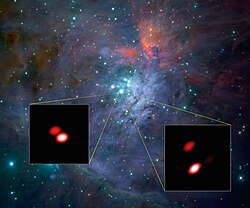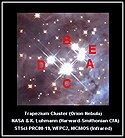Theta1 Orionis C
| Mehrfachstern Theta1 Orionis C | |||||||||||||||||||
|---|---|---|---|---|---|---|---|---|---|---|---|---|---|---|---|---|---|---|---|
 | |||||||||||||||||||
| Unten rechts eine Nahaufnahme des Doppelsterns Theta1 Orionis C aufgenommen mit dem GRAVITY instrument des VLTI. | |||||||||||||||||||
| AladinLite | |||||||||||||||||||
| Beobachtungsdaten Äquinoktium: J2000.0, Epoche: J2000.0 | |||||||||||||||||||
| Sternbild | Orion | ||||||||||||||||||
| Rektaszension | 05h 35m 16,47s [1] | ||||||||||||||||||
| Deklination | −05° 23′ 22,9″ [1] | ||||||||||||||||||
| Helligkeiten | |||||||||||||||||||
| Scheinbare Helligkeit | 5,13 mag [2] | ||||||||||||||||||
| Spektrum und Indices | |||||||||||||||||||
| B−V-Farbindex | +0,02 [3] | ||||||||||||||||||
| U−B-Farbindex | −0,95 [3] | ||||||||||||||||||
| R−I-Index | +0,18 [3] | ||||||||||||||||||
| Spektralklasse | O7 V 09.5 ? [4] | ||||||||||||||||||
| Astrometrie | |||||||||||||||||||
| Radialgeschwindigkeit | (24,5 ± 1,2) km/s [1] | ||||||||||||||||||
| Parallaxe | 2,50 ± 0,14 mas [1] | ||||||||||||||||||
| Entfernung | ca. 1300 Lj ca. 400 pc | ||||||||||||||||||
| Eigenbewegung [1] | |||||||||||||||||||
| Rek.-Anteil: | 2,26 ± 0,10 mas/a | ||||||||||||||||||
| Dekl.-Anteil: | 0,99 ± 0,08 mas/a | ||||||||||||||||||
| Physikalische Eigenschaften | |||||||||||||||||||
| Masse | 33,5 12 1 M☉ [4] | ||||||||||||||||||
| Radius | 8 R☉ | ||||||||||||||||||
| Leuchtkraft | 250000 L☉ | ||||||||||||||||||
| Effektive Temperatur | 45500 K | ||||||||||||||||||
| Alter | 1.2 · 106 a | ||||||||||||||||||
| Andere Bezeichnungen und Katalogeinträge | |||||||||||||||||||
| |||||||||||||||||||
Theta1 Orionis C (θ1 Orionis C, θ1 Ori C, auch 41 Ori C) ist ein Mehrfachsternsystem und der hellste Stern des Trapez im Orionnebel. Seine Bestandteile C1 und C2 haben von der Erde aus gesehen einen Winkelabstand von 0"04, d. h. von 4 Hundertstel einer Winkelsekunde. C3 umrundet C1 sogar in weit geringerer Distanz.
Eigenschaften
Theta1 Orionis C1 ist ein Blauer Riese (34 Sonnenmassen) der Hauptreihe, der die Charakteristika der Spektralklasse O zeigt. Seine Oberflächentemperatur ist mit 45.000 K extrem hoch. Die geschätzte absolute Helligkeit im sichtbaren Licht ist −3,2. Er ist damit einer der hellsten bekannten Sterne. Wegen der recht großen Entfernung von ca. 1300 Lichtjahren liegt die scheinbare Helligkeit aber nur bei einer Magnitude von 5,1.
Theta1 Orionis C1 produziert den größten Teil der Ultraviolettstrahlung, die den Orionnebel ionisiert und so auch dessen Leuchten hervorruft. Zudem produziert er einen Sternwind, der etwa 100.000-mal stärker ist als der der Sonne. Die Teilchen des Sternwindes bewegen sich mit 1.000 km/s fort. Theta1 Orionis C1 ist weiterhin eine variable Röntgenquelle. Auch eine von dessen Sternenwind erzeugte Millionen Grad heiße Plasmablase erzeugt Röntgenstrahlung.[5]
Theta1 Orionis C1 hat 2 weitere Begleiter. Theta1 Orionis C2 mit Spektralklasse O9.5 hat etwa 12 Sonnenmassen und befindet sich etwa 18 AE entfernt. Ein weiterer Begleiter C3 umrundet die große Komponente C1 in einem engen Abstand von lediglich etwa 0,4 AE.[4]
Komponente C1 wird vermutlich in wenigen Millionen Jahren als Supernova explodieren.
Stern im Trapez
Der Orionnebel expandiert aufgrund des Sternenwindes. Diverse maximale Expansionsgeschwindigkeiten relativ zu den Trapezsternen konnten bereits ab den späten 1950er Jahren anhand von Emissionslinien verschiedener Ionen sowie der 21-cm-Radioemission neutralen Wasserstoffs gemessen werden.[6]
Die Sterne des Trapez werden mit bloßem Auge insgesamt als ein einziger Stern wahrgenommen (Theta1 Orionis). Das meiste Licht von Theta1 Orionis stammt jedoch von dessen Komponente C. Es kann daher gesagt werden, dass Theta1 Orionis C1 die höchste Oberflächentemperatur von allen mit bloßem Auge sichtbaren Sternen hat.
Alle Sterne des Trapez mit Benennung
Ein weiteres Bild der Sterne von Theta1 Orionis inkl. Theta1 Orionis C
Literatur
- N. R. Walborn: Systematic variations in the spectrum of Theta-1 Orionis C. In: Astrophysical Journal. 243. Jahrgang, Nr. 1, 1981, S. L37–L39, doi:10.1086/183438.
- Marc Gagne, et al.: Periodic X-Ray Emission from the O7 V Star θ1 Orionis C. In: Astrophysical Journal Letters. 478. Jahrgang, Nr. 2, 1997, S. L87–L90, doi:10.1086/310558.
Weblinks
- Theta-1 Orionis by James B. Kaler.
Einzelnachweise
- ↑ a b c d tet01 Ori C. In: SIMBAD. Centre de Données astronomiques de Strasbourg, abgerufen am 2. Mai 2022.
- ↑ Hipparcos-Katalog (ESA 1997)
- ↑ a b c Bright Star Catalogue
- ↑ a b c GRAVITY collaboration: Multiple star systems in the Orion nebula. In: Astronomy & Astrophysics. 620. Jahrgang, 2018, S. A116, doi:10.1051/0004-6361/201833575, arxiv:1809.10376, bibcode:2018A&A...620A.116G.
- ↑ https://www.mpia.de/news/wissenschaft/2007-10-orion-nebel Manuel Güdel: Millionen Grad heißes Gas im Orion-Nebel entdeckt, Meldung des Max-Planck-Institutes für Astronomie am 30. November 2007, abgerufen am 13. März 2020
- ↑ Kaler, J. B.: Radial Velocities in the Orion Nebula, in: Astrophysical Journal, Jg. 148 (1967), S. 925. bibcode:1967ApJ...148..925K.
Auf dieser Seite verwendete Medien
Autor/Urheber: IAU and Sky & Telescope magazine (Roger Sinnott & Rick Fienberg), Lizenz: CC BY 3.0
Central bright 'hunting God' between parts of Taurus and Gemini & 5 others. Hourglass form inc. diag. tight belt of 3, so 7 stars of stunning c. 0-1 mag. dominated by blue/white Rigel in SW (of -1. mag). M42, M43 deep-space between mid-leg lines.
Autor/Urheber: ESO/GRAVITY consortium/NASA/ESA/M. McCaughrean, Lizenz: CC BY 4.0
As part of the first observations with the new GRAVITY instrument the team looked closely at the bright, young stars known as the Trapezium Cluster, located in the heart of the Orion star-forming region. Already, from these first data, GRAVITY made a discovery: one of the components of the cluster (Theta1 Orionis F, lower left) was found to be a double star for the first time. The brighter double star Theta1 Orionis C (lower right) is also well seen. The background image comes from the ISAAC instrument on ESO's Very Large Telescope. The views of two of the stars from GRAVITY, shown as inserts, reveal far finer detail than could be detected with the NASA/ESA Hubble Space Telescope.
Opaque red circle
Autor/Urheber: Debeo Morium, Lizenz: CC BY-SA 3.0
Orion Nebula - Core Details & Trapezium - Common Names
This is a charted version of a shot i did, the uncharted version is posted here: Orion Nebula Core - Uncharted for comparison, also check out this detailed chart of all the stars: Orion Nebula - Charted. Basically i overlaid all the major stars in the vicinity so you can see the names.s You need to look at it full size though to read the labels. Ill also post below the description from the original:
This is a shot of the Orion Nebula (NGC 1976 / The Great Nebula in Orion / M42) taken on November 12th 2010. This shot also includes a faint wisp of De Mairan's Nebula (NGC 1982 / M43). The shot was taken with an EQ-6 Mount, no Autoguider, and an 800mm focal length, 8" Aperture f/4 Newtonian Telescope using my Canon Rebel T1i as an imager. I used a 3x barlow without an eyepiece. The majority of the shot is the result of 6 stacked 30 second 3200 ISO shots. A stack of 15 additional shots were used on the Trapezium star cluster in the center. This shot was also post-processed to improve contrast and light levels. The primary goal was to show the detail of the inner core of the Orion Nebula.
Taken by Jeffrey Phillips Freeman.From a HST Image (http://upload.wikimedia.org/wikipedia/commons/b/b3/Orion.Nebula.M42.Trapezium.Cluster.VIS-IR.HST.jpg), I cut the center section of the NICMOS/infrared image with the Trapezium stars, made a new image from it, and named the stars.







